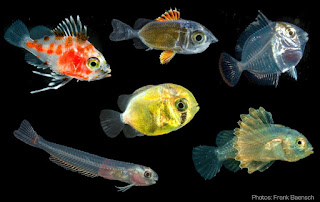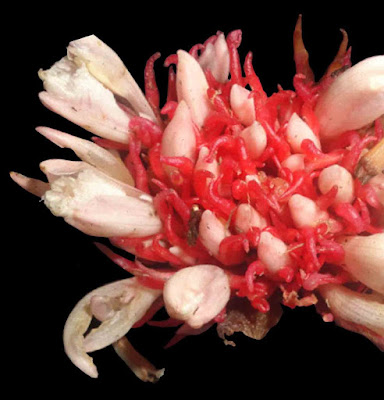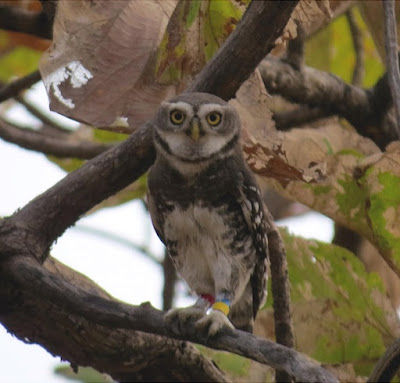[Most Recent Entries] [Calendar View]
Wednesday, February 28th, 2018
| Time | Event | ||||
| 9:28a | [Ichthyology • 2018] Larval Swimming Capacities Affect Genetic Differentiation and Range Size in Demersal Marine Fishes
ABSTRACT Dispersal is a fundamental process governing the ecological and evolutionary dynamics of any given species. Due to inherent challenges associated with measuring dispersal directly, identifying proxies for dispersal capacity has long been an active field of research across ecosystems. In marine systems, pelagic larval duration (PLD) has been one of the most widely used indicators of interspecific dispersal potential. The validity of this proxy, however, relies mostly on the assumption of entirely passive dispersal, a notion that has been challenged by findings of strong larval behavioural capabilities. Here, we assessed the effect of larval swimming capacities measured as mean critical swimming speed (U-crit) on emergent species-level properties related to dispersal potential, population genetic structure and global range size, in demersal marine fishes. In a meta-analytic framework, we tested the relative importance of U-crit versus other intrinsic (PLD, egg type, adult body size) and extrinsic (genetic marker type, study scale) predictors of isolation-by-distance slope, global FST and range size. U-crit showed stronger relationships with all emergent response variables than PLD and was consistently the most important predictor in multi-model inference. Our findings indicate that larval swimming capacities could serve as a powerful indicator of a species’ long-distance dispersal potential. KEY WORDS: Larval dispersal · Critical swimming speed · Connectivity · Genetic structure · Isolation-by-distance · Range size Gerrit B. Nanninga and Andrea Manica. 2018. Larval Swimming Capacities Affect Genetic Differentiation and Range Size in Demersal Marine Fishes. Mar Ecol Prog Ser. 589;1-12. DOI: 10.3354/meps12515 | ||||
| 3:13p | [Botany • 2018] Amomum riwatchii • A New Species (Zingiberaceae) from northeastern India
Abstract Amomum riwatchii, a new species of Zingiberaceae from northeastern India is described and illustrated. It is similar to A. carnosum, but differs from the latter in having non-stoloniferous rhizome, oblong lanceolate lamina, 5−6 mm long ligule with entire apex, broadly ovate or orbicular dark red thick outer bract, calyx lobes with cuspidate or horned apex, oblong labellum with entire apex and non-winged capsule. Keywords: Amomum, Arunachal Pradesh, India, new species, Zingiberales Vadakkoot Sankaran Hareesh and Mamiyil Sabu. 2018. Amomum riwatchii (Zingiberaceae): A New Species from northeastern India. Botany Letters. DOI: 10.1080/23818107.2018.1437073 | ||||
| 4:32p | [Ornithology • 2018] Athene blewitti • The Critically Endangered Forest Owlet Heteroglaux blewitti is nested within the Currently Recognized Athene Clade: A Century-old Debate Addressed
Abstract Range-restricted species generally have specific niche requirements and may often have unique evolutionary histories. Unfortunately, many of these species severely lack basic research, resulting in poor conservation strategies. The phylogenetic relationship of the Critically Endangered Forest Owlet Heteroglaux blewitti has been the subject of a century-old debate. The current classifications based on non-phylogenetic comparisons of morphology place the small owls of Asia into three genera, namely, Athene, Glaucidium, and Heteroglaux. Based on morphological and anatomical data, H. blewitti has been alternatively hypothesized to belong within Athene, Glaucidium, or its own monotypic genus Heteroglaux. To test these competing hypotheses, we sequenced six loci (~4300 bp data) and performed phylogenetic analyses of owlets. Mitochondrial and nuclear trees were not congruent in their placement of H. blewitti. However, both mitochondrial and nuclear combined datasets showed strong statistical support with high maximum likelihood bootstrap (>/ = 90) and Bayesian posterior probability values (>/ = 0.98) for H. blewitti being nested in the currently recognized Athene group, but not sister to Indian A. brama. The divergence of H. blewitti from its sister taxa was between 4.3 and 5.7 Ma coinciding with a period of drastic climatic changes in the Indian subcontinent. This study presented the first genetic analysis of H. blewitti, a Critically Endangered species, and addressed the long debate on the relationships of the Athene-Heteroglaux-Glaucidium complex. We recommend further studies with more data and complete taxon sampling to understand the biogeography of Indian Athene species.
Pankaj Koparde, Prachi Mehta, Sushma Reddy, Uma Ramakrishnan, Shomita Mukherjee and V. V. Robin. 2018. The Critically Endangered Forest Owlet Heteroglaux blewitti is nested within the Currently Recognized Athene clade: A Century-old Debate Addressed. PLoS ONE. 13(2): e0192359. DOI: 10.1371/journal.pone.0192359 |
| << Previous Day |
2018/02/28 [Calendar] |
Next Day >> |



